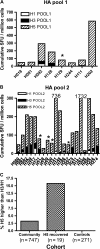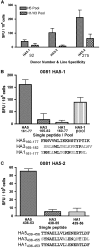Identification of H5N1-specific T-cell responses in a high-risk cohort in vietnam indicates the existence of potential asymptomatic infections
- PMID: 22080094
- PMCID: PMC3242740
- DOI: 10.1093/infdis/jir689
Identification of H5N1-specific T-cell responses in a high-risk cohort in vietnam indicates the existence of potential asymptomatic infections
Abstract
Background: Most reported human H5N1 viral infections have been severe and were detected after hospital admission. A case ascertainment bias may therefore exist, with mild cases or asymptomatic infections going undetected. We sought evidence of mild or asymptomatic H5N1 infection by examining H5N1-specific T-cell and antibody responses in a high-risk cohort in Vietnam.
Methods: Peripheral blood mononuclear cells were tested using interferon-γ enzyme-linked immunospot T assays measuring the response to peptides of influenza H5, H3, and H1 hemagglutinin (HA), N1 and N2 neuraminidase, and the internal proteins of H3N2. Horse erythrocyte hemagglutination inhibition assay was performed to detect antibodies against H5N1.
Results: Twenty-four of 747 individuals demonstrated H5-specific T-cell responses but little or no cross-reactivity with H3 or H1 HA peptides. H5N1 peptide-specific T-cell lines that did not cross-react with H1 or H3 influenza virus HA peptides were generated. Four individuals also had antibodies against H5N1.
Conclusions: This is the first report of ex vivo H5 HA-specific T-cell responses in a healthy but H5N1-exposed population. Our results indicate that the presence of H5N1-specific T cells could be an additional diagnostic tool for asymptomatic H5N1 infection.
Figures



References
-
- Beigel JH, Farrar J, Han AM, et al. Avian influenza A (H5N1) infection in humans. N Engl J Med. 2005;353:1374–85. - PubMed
-
- Gambotto A, Barratt-Boyes SM, de Jong MD, Neumann G, Kawaoka Y. Human infection with highly pathogenic H5N1 influenza virus. Lancet. 2008;371:1464–75. - PubMed
-
- World Health Organization. Confirmed human cases of avian influenza A(H5N1). Avian Influenza Weekly Update 302. 14 October 2011. http://www.who.int/influenza/human_animal_interface/H5N1_cumulative_tabl.... Accessed 8 April 2011.
Publication types
MeSH terms
Substances
Grants and funding
LinkOut - more resources
Full Text Sources
Other Literature Sources
Medical

